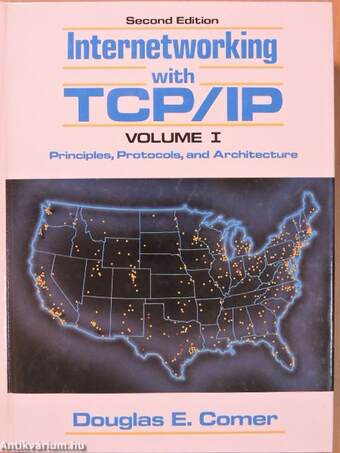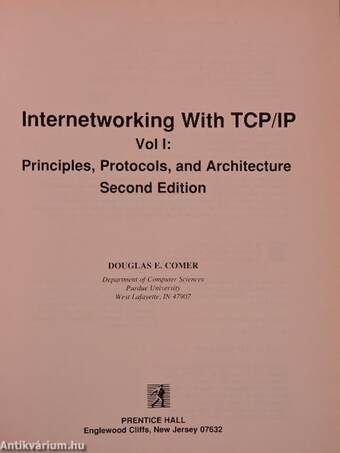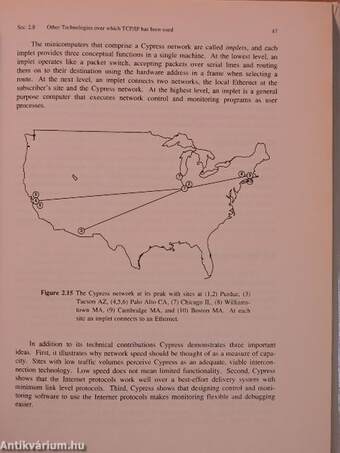1.062.486
kiadvánnyal nyújtjuk Magyarország legnagyobb antikvár könyv-kínálatát

VISSZA
A TETEJÉRE
JAVASLATOKÉszre-
vételek
Internetworking with TCP/IP I.
Principles, Protocols, and Architecture
| Kiadó: | Prentice Hall |
|---|---|
| Kiadás helye: | New Jersey |
| Kiadás éve: | |
| Kötés típusa: | Fűzött kemény papírkötés |
| Oldalszám: | 547 oldal |
| Sorozatcím: | |
| Kötetszám: | |
| Nyelv: | Angol |
| Méret: | 24 cm x 18 cm |
| ISBN: | 0-13-468505-9 |
| Megjegyzés: | 2. kiadás. Fekete-fehér ábrákkal. |
naponta értesítjük a beérkező friss
kiadványokról
naponta értesítjük a beérkező friss
kiadványokról
Fülszöveg
Douglas E. Comer Reflecting the most recent changes in the field, Internetworking with TCP/IP is the reference for anyone working with the TCP/IP suite. The first volume of this bestselling book provides a broad, conceptual introduction to the TCP/IP internetworking protocols and the connected TCP /IP Internet. Known for its clarity and accessibility, this text and reference reviews network hardware, including the wide area national backbones ARPANET and NSFnet and local area technologies Ethernet and tokén rings. Address binding (ARP) and the IP concepts of connectionless datagram delivery, error detection and control, multicasting, and routing are covered. Comer compares the ISO 7-layer reference model to the TCP/IP 5-layer model in this discussion of protocol layering and describes the socket interface between application programs and protocol software. In addition, Volume I: • presents routing architectures for large internets and describes their gateways: EGP, RIP, and OSPF. •... TovábbFülszöveg
Douglas E. Comer Reflecting the most recent changes in the field, Internetworking with TCP/IP is the reference for anyone working with the TCP/IP suite. The first volume of this bestselling book provides a broad, conceptual introduction to the TCP/IP internetworking protocols and the connected TCP /IP Internet. Known for its clarity and accessibility, this text and reference reviews network hardware, including the wide area national backbones ARPANET and NSFnet and local area technologies Ethernet and tokén rings. Address binding (ARP) and the IP concepts of connectionless datagram delivery, error detection and control, multicasting, and routing are covered. Comer compares the ISO 7-layer reference model to the TCP/IP 5-layer model in this discussion of protocol layering and describes the socket interface between application programs and protocol software. In addition, Volume I: • presents routing architectures for large internets and describes their gateways: EGP, RIP, and OSPF. • explains TCP transport services -sliding windows and windowmanagement, -reiiable stream service, -end-to-end acknowledgement, -flow control, and -encapsulation. • details adaptive retransmission and the Karn/Patridge and Jacobson slow-start congestion control schemes. • examines application services -electronic mail (SMTP), -file transfer and access (FTP, TFTP, NFS), -remote login (ELNET, Rlogin), and -network management protocols (SNMP, ASN. 1, CMOT) Alsó available from Prentice Hall INTERNETWORKING WITH TCP/IP Volume II: Implementation and Internals by Douglas E. Comer and Dávid L. Stevens ISBN G-13-MbflSDS PRENTICE HALL Englewood Cliffs, N.J. 07632 9780134685052 VisszaTartalom
ContentsForeword
xix
Preface
xxi
Chapter 1 Introduction and Overview
1
1.1 The Need For An Internet 1
1.2 The TCP/IP Internet 2
1.3 Internet Services 3
1.4 History And Scope OfThe Internet 6
1.5 The Originál Internet Activities Board 8
1.6 The New IAB Organization 9
1.7 Internet Request For Comments 11
1.8 Internet Protocols and Standardization 12
1.9 Future Growth and Technology 12
1.10 The FNC And The NREN 13
1.11 Organization OfThis Text 14
1.12 Summary 15
Chapter 2 Review of Underlying Network Technologies 17
2.1 Introduction 17
2.2 Two Approaches To Network Communication 18
2.3 Wide Area, Metropolitan Area, and Local Area Neh\'orks 19
2.4 Ethernet Technology 20
2.5 ProNET Tokén Ring Technology 28
2.6 ARPANET Technology 33
2.7 National Science Foundation Networking 36
2.8 Other Technologies over which TCP HP has been used 44
2.9 Summary And Conclusion 48
Chapter 3 Internetworking Concept and Architectural Model
51
3.1 Introduction 51
3.2 Application-Level Interconnection 51
3.3 Network-Level Interconnection 52
3.4 Properties Of The Internet 53
3.5 Internet Architecture 54
3.6 Interconnection Through IP Gateways or Routers 54
3.7 The User's View 56
3.8 All Networks Are Equal 56
3.9 The Unanswered Questions 57
3.10 Summary 58
Chapter 4 Internet Addresses 61
4.1 Introduction 61
4.2 Universal Identifiers 61
4.3 Three Primary Classes Of IP Addresses 62
4.4 Addresses Specify Network Connections 63
4.5 Network And Broadcast Addresses 63
4.6 Limited Broadcast 64
4.7 Interpreting Zero To Mean "This" 64
4.8 Weaknesses In Internet Addressing 65
4.9 Dotted Decimai Notation 66
4.10 Loopback Address 67
4.11 Summary Of Special Address Conventions 67
4.12 Internet Addressing Authority 68
4.13 An Example 68
4.14 Network Byte Order 69
4.15 Summary 70
Chapter 5 Mapping Internet Addresses to Physical Addresses (ARP) 73
5.1 Introduction 73
5.2 The Address Resolution Problem 73
5.3 Two Types Of Physical Addresses 74
5.4 Resolution Through Direct Mapping 74
5.5 Resolution Through Dynamic Binding 75
5.6 The Address Resolution Cache 76
5.7 ARP Refinements 77
5.8 Relationship Of ARP To Other Protocols 77
5.9 ARP Implementation 77
5.10 ARP Encapsulation And Identification 79
5.11 ARP Protocol Formát 79
5.12 Summary 80
Chapter 6 Determining an Internet Address at Startup (RARP) 83
6.1 Introduction 83
6.2 Reverse Address Resolution Protocol (RARP) 84
6.3 Timing RARP Transactions 86
6.4 Primary And Backup RARP Servers 86
6.5 Summary 87
Chapter 7 Internet Protocol: Connectionless Datagram Delivery 89
7.1 Introduction 89
7.2 A Virtual Network 89
7.3 Internet Architecture And Philosophy 90
7.4 The Concept Of Unreliable Delivery 90
7.5 Connectionless Delivery System 91
7.6 Purpose Of The Internet Protocol 91
7.7 The Internet Datagram 91
7.8 Internet Datagram Options 100
7.9 Summary 106
Chapter 8 Internet Protocol: Routing IP Datagrams 109
8.1 Introduction 109
8.2 Routing In An Internet 109
8.3 Direct And Indirect Delivery 111
8.4 Table-Driven IP Routing 113
8.5 Default Routes 115
8.6 Host-Specific Routes 115
8.7 The Final Algorithm 115
8.8 Routing With IP Addresses 116
8.9 Handling Incoming Datagrams 118
8.10 Establishing Routing Tables 119
8.11 Summary 119
Chapter 9 Internet Protocol: Error and Control Messages (ICMP)
123
9.1 Introduction 123
9.2 The Internet Control Message Protocol 123
9.3 Error Reporting vs. Error Correction 124
9.4 ICMP Message Delivery 125
9.5 ICMP Message Formát 126
9.6 Testing Destination Reachability And Status 127
9.7 Echo Request And Reply Message Formát 128
9.8 Reports Of Unreachable Destinations 128
9.9 Congestion And Datagram Flow Control 130
9.10 Source Quench Formát 130
9.11 Route Change Requests From Gateways 131
9.12 Detecting Circular Or Excessively Long Routes 133
9.13 Reporting Other Problems 134
9.14 Clock Synchronization And Transit Time Estimation 134
9.75 Information Request And Reply Messages 136
9.16 Obtaining A Subnet Mask 136
9.17 Summary 137
Chapter 10 Protocol Layering 139
10.1 Introduction 139
10.2 The Ne ed For Multiple Protocols 139
10.3 The Conceptual Layers Of Protocol Software 140
10.4 Functionality Of The Layers 143
10.5 CCITT X.25 And Its Relation To The ISO Model 144
10.6 Differences Between X.25 And Internet Layering 147
10.7 The Protocol Layering Principle 149
10.8 Layering In The Presence Of Network Substructure 151
10.9 Two Important Boundaries In The TCPIIP Model 153
10.10 The Disadvantage Of Layering 154
10.11 The Basic Idea Behind Multiplexing And Demultiplexing 154
10.12 ISO's OSI Protocols 156
10.13 Summary 157
Chapter 11 User Datagram Protocol 159
11.1 Introduction 159
11.2 Identifying The Ultimate Destination 159
11.3 The User Datagram Protocol 160
11.4 Formát Of UDP Messages 161
11.5 UDP Pseudo-Header 162
11.6 UDP Encapsulation And Protocol Layering 163
11.7 Layering And The UDP Checksum Computation 165
11.8 UDP Multiplexing, Demultiplexing, And Ports 165
11.9 Keserved And Available UDP Port Numbers 166
11.10 Summary 168
Chapter 12 Reliable Stream Transport Service (TCP)
12.1 Introduction 171
12.2 The Need For Stream Delivery 171
12.3 Properties Of The Reliable Delivery Service 172
12.4 Providing Reliability 173
12.5 The Idea Behind Sliding Windows 175
12.6 The Transmission Control Protocol 177
12.7 Ports, Connections, And Endpoints 178
12.8 Passive And Active Opens 180
12.9 Segments, Streams, And Sequence Numbers 181
12.10 Variable Window Size And Flow Control 182
12.11 TCP Segment Formát 183
12.12 Out OfBand Data 184
12.13 Maximum Segment Size Option 185
12.14 TCP Checksum Computation 186
12.15 Acknowledgements And Retransmission 187
12.16 Timeout And Retransmission 188
12.17 Accurate Measurement Of Round Trip Samples 190
12.18 Karn's Algorithm And Timer Backojf 191
12.19 Responding To High Variance In Delay 192
12.20 Response To Congestion 192
12.21 Establishing A TCP Connection 194
12.22 Initial Sequence Numbers 196
12.23 Closing a TCP Connection 196
12.24 TCP Connection Reset 198
12.25 TCP State Machine 198
12.26 Forcing Data Delivery 200
12.27 Re served TCP Port Numbers 200
12.28 TCP Performance 200
12.29 Summary 202
Chapter 13 Routing: Cores, Peers, and Algorithms (GGP)
205
13.1 Introduction 205
13.2 The Origin Of Gateway Routing Tahles 206
13.3 Routing With Partial Information 207
13.4 Originál Internet Architecture And Cores 208
13.5 Core Gateways 209
13.6 Beyond The Core Architecture To Peer Backbones 212
13.7 Automatic Route Propagation 214
13.8 Vector Distance (Bellman-Ford) Routing 214
13.9 Gateway-To-Gateway Protocol (GGP) 216
13.10 GGP Message Formáts 216
13.11 Link-State (SPF) Routing 218
13.12 SPF Protocols 219
13.13 Summary 220
Chapter 14 Routing: Autonomous Systems (EGP) 223
14.1 Introduction 223
14.2 Adding Complexity To The Architectural Model 223
14.3 A Fundamental Idea: Extra Hops 224
14.4 Autonomous System Concept 226
14.5 Exteriőr Gateway Protocol (EGP) 228
14.6 EGP Message Header 229
14.7 EGP Neighbor Acquisition Messages 230
14.8 EGP Neighbor Reachability Messages 231
14.9 EGP Poll Request Messages 232
14.10 EGP Routing Update Messages 234
14.11 Measuring From The Receiver's Perspective 235
14.12 The Key Restriction Of EGP 236
14.13 Technical Problems 238
14.14 Decentralization Of The Internet Architecture 239
14.15 Beyond Autonomous Systems 239
14.16 Summary 240
Chapter 15 Routing: Interior Gateway Protocols (RIP, OSPF, HELLO) 243
15.1 Introduction 243
15.2 Static Vs. Dynamic Interior Routes 243
15.3 Routing Information Protocol (RIP) 246
15.4 The Hello Protocol 252
15.5 Combining RIP, Hello, And EGP 254
15.6 The Open SPF Protocol (OSPF) 255
15.7 Routing With Partial Information 262
15.8 Summary 262
Chapter 16 Transparent Gateways And Subnet Addressing
16.1 Introduction 265
16.2 Review Of Relevant Facts 265
16.3 Minimiiing Network Numbers 266
16.4 Transparent Gateways 267
16.5 Proxy ARP 268
16.6 Subnet Addresses 270
16.7 Flexibility In Subnet Address Assignment 272
16.8 Implementation Of Subnets With Masks 273
16.9 Subnet Mask Representation 274
16.10 Routing In The Presence Of Subnets 275
16.11 The Subnet Routing Algorithm 276
16.12 Unified Routing Algorithm 276
16.13 Maintenance Of Subnet Masks 278
16.14 Broadcasting To Subnets 278
16.15 Summary 279
Chapter 17 Multicast Addressing (IGMP)
17.1 Introduction 281
17.2 Hardware Broadcast 281
17.3 Hardware Multicast 282
17.4 IP Multicast 283
17.5 IP Multicast Addresses 283
17.6 Mapping IP Multicast To Ethernet Multicast 284
17.7 Extending IP To Handlé Multicasting 285
17.8 Internet Group Management Protocol 286
17.9 IGMP Implementation 286
17.10 Group Membership State Transitions 287
17.11 IGMP Message Formát 288
17.12 Multicast Address Assignment 289
17.13 Propagating Routing Information 289
17.14 Summary 290
Chapter 18 Client-Server Model Of Interaction
293
18.1 Introduction 293
18.2 The Client-Server Model 293
18.3 A Simple Example: UDP Echo Server 294
18.4 Time And Date Service 296
18.5 The Complexity of Servers 297
18.6 RARP Server 298
18.7 Alternatives To The Client-Server Model 299
18.8 Summary 300
Chapter 19 Bootstrap Protocol (BOOTP) 303
19.1 Introduction 303
19.2 Introduction 303
19.3 Using IP To Determine An IP Address 304
19.4 The BOOTP Retransmission Policy 305
19.5 BOOTP Message Formát 306
19.6 The Two-Step Bootstrap Procedure 307
19.7 Vendor-Specific Field 308
19.8 Summary 309
Chapter 20 The Domain Name System 311
20.1 Introduction 311
20.2 Names For Machines 311
20.3 Fiat Namespace 312
20.4 Hierarchical Names 313
20.5 Delegation Of Authority For Names 313
20.6 Subset Authority 314
20.7 TCPIIP Internet Domain Names 315
20.8 Official And Unofficial Internet Domain Names 316
20.9 ltems Named And Syntax Of Names 319
20.10 Mapping Domain Names To Addresses 319
20.11 Domain Name Resolution 321
20.12 Efficient Translation 322
20.13 Caching: The Key To Efficiency 323
20.14 Domain Server Message Formát 324
20.15 Compressed Name Formát 327
20.16 Abbreviation Of Domain Names 328
20.17 Inverse Mappings 329
20.18 Pointer Queries 329
20.19 Object Types And Resource Record Contents 330
20.20 Obtaining Authority For A Subdomain 331
20.21 Summary 332
Chapter 21 The Socket Interface 335
21.1 Introduction 335
21.2 The UNIX I/O Paradigm And Network 1/0 336
21.3 Adding Network 1/0 to UNIX 336
21.4 The Socket Abstraction 337
21.5 Creating A Socket 337
21.6 Socket Inheritance And Termination 338
21.7 Specifying A Local Address 339
21.8 Connecting Sockets To Destination Addresses 340
21.9 Sending Data Through A Socket 341
21.10 Receiving Data Through A Socket 343
21.11 Obtaining Locai And Remote Socket Addresses 344
21.12 Obtaining And Setting Socket Options 345
21.13 Specifying A Queue Length For A Server 346
21.14 How A Server Accepts Connections 346
21.15 Servers That Handlé Multiple Services 347
21.16 Obtaining And Setting The Host Names 348
21.17 Obtaining And Setting The Internál Host Domain 349
21.18 4BSD UNIX Network Library Calls 349
21.19 Network Byte Order Conversion Routines 350
21.20 IP Address Manipulation Routines 351
21.21 Accessing The Domain Name System 352
21.22 Obtaining Information About Hosts 354
21.23 Obtaining Information About Networks 355
21.24 Obtaining Information About Protocols 355
21.25 Obtaining Information About Network Services 356
21.26 An Example Client 357
21.27 An Example Server 359
21.28 Summary 362
Chapter 22 Applications: Remote Login (TELNET, Rlogin) 365
22.1 Introduction 365
22.2 Remote Interactive Computing 365
22.3 TELNET Protocol 366
22.4 Accommodating Heterogeneity 368
XVI
Contents
22.5 Passing Commands That Control The Remote Side 370
22.6 Forcing The Server To Read A Control Function 372
22.7 TELNET Options 372
22.8 TELNET Option Negotiation 373
22.9 Rlogin (4BSD UNIX) 374
22.10 Summary 375
Chapter 23 Applications: File Transfer And Access (FTP, TFTP, NFS) 377
23.1 Introduction 377
23.2 File Access And Transfer 377
23.3 On-line Shared Access 378
23.4 Sharing By File Transfer 379
23.5 FTP: The Major TCP/IP File Transfer Protocol 379
23.6 FTP Features 380
23.7 FTP Process Model 380
23.8 TCP Port Numher Assignment 382
23.9 The User's View Of FTP 382
23.10 An Example Anonymous FTP Session 384
23.11 TFTP 385
23.12 NFS 387
23.13 NFS Implementation 387
23.14 Remote Procedure Call (RPC) 388
23.15 Summary 389
Chapter 24 Applications: Electronic Mail (822, SMTP) 391
24.1 Introduction 391
24.2 Electronic Mail 391
24.3 Mailhox Names And Aliases 393
24.4 Alias Expansion And Mail Forwarding 393
24.5 The Relationship Of Internetworking And Mail 394
24.6 TCP/IP Standard For Electronic Mail Service 396
24.7 Electronic Mail Addresses 397
24.8 Pseudo Domain Addresses 398
24.9 Simple Mail Transfer Protocol (SMTP) 399
24.10 Summary 401
Contents
xvii
Chapter 25 Applications: Internet Management (SNMP, CMOT) 403
25.1 Introduction 403
25.2 The Level Of Management Protocols 403
25.3 Architectural Model 404
25.4 Protocol Architecture 406
25.5 Common Management Information Base 406
25.6 Examples of MIB Variahles 407
25.7 The Structure Of Management Information 408
25.8 Formai Definitions Using ASN.l 409
25.9 Structure And Representation Of MIB Ohject Names 409
25.10 Simple Network Management Protocol 414
25.11 SNMP Message Formát 416
25.12 Example Encoded SNMP Message 418
25.13 Summary 419
Chapter 26 Summary Of Protocol Dependencies 421
26.1 Introduction 421
26.2 Protocol Dependencies 421
26.3 Application Program Access 423
26.4 Summary 424
Chapter 27 TCP/IP Internet Research And Engineering Problems 427
27.1 Introduction 427
27.2 The Forces Stimulating Evolution 428
27.3 Routing In An Expanded Internet 430
27.4 Finding Users 431
27.5 Finding Services 432
27.6 Managing Networks 432
27.7 Automatic Configuration 433
27.8 New Applications 434
27.9 High-Speed Communication Technologies 437
27.10 Reliable Transactions 438
27.11 Security 439
27.12 Summary 439
xviii Contents
Appendix 1 A Guide To RFCs 441
Appendix 2 Glossary Of Internetworking Terms and Abbreviations 477
Appendix 3 Standardization And Official TCP/IP Protocol Standards 513
Appendix 4 Examples Of Internet Information Archives 523
Bibliography 527
Index 535
Témakörök
Douglas E. Comer
Douglas E. Comer műveinek az Antikvarium.hu-n kapható vagy előjegyezhető listáját itt tekintheti meg: Douglas E. Comer könyvek, művekMegvásárolható példányok
Nincs megvásárolható példány
A könyv összes megrendelhető példánya elfogyott. Ha kívánja, előjegyezheti a könyvet, és amint a könyv egy újabb példánya elérhető lesz, értesítjük.







